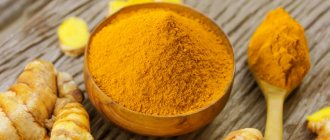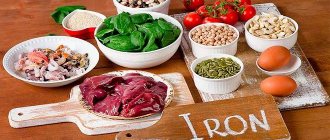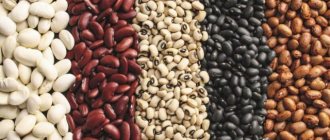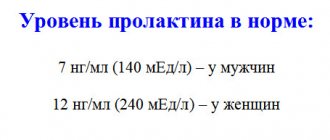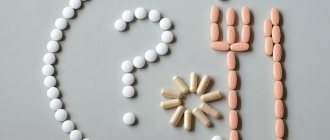Medical practice shows that the amount of iron required for the full functioning of the female body varies for each person.
Iron levels are determined by a woman’s age, her state of health and lifestyle. The article will tell you what daily norms of this element should enter the body, what its excess and deficiency lead to.
What is iron?
It's metal. In organs and tissues, iron is found in approximately 3-5 grams. This is not much, but such a small dose is enough for the body to successfully continue its existence. Four-fifths of all iron is contained in hemoglobin, the rest is scattered throughout the body and distributed in the liver, muscles, bones, etc. Some of the internal iron is included in enzymes.
Over time, a natural loss of the mineral occurs, and therefore a person needs a constant supply of some dosages of iron. It is lost in urine and sweat; in women, iron consumption is also associated with monthly losses during menstruation.
Why is iron needed in the body?
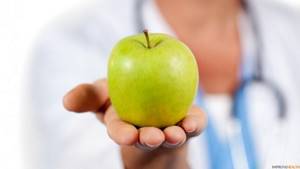
Iron is a component of hemoglobin. And accordingly, it participates in hematopoiesis and oxygen transfer to tissues. Iron helps normal biological oxidation. But most importantly, iron helps normalize the muscle and nervous system. If a person constantly has a feeling of weakness and fatigue, then there is a lack of iron.
Increased iron requirement
An increased need for iron is inherent in the following groups of people:
• Women during the period after menstruation. Blood loss, even if small, requires compensation for the hemoglobin content in the blood. • Pregnant and lactating women. During pregnancy, a significant consumption of iron is carried out to build the fetal body, and nursing mothers spend their iron on feeding the child (it passes into breast milk). Literally every second pregnant woman shows signs of iron deficiency, which indicates a significant increase in the need for this element in expectant mothers. • After injuries, blood loss, major surgical operations.
Iron is a very valuable element. In this regard, the body has learned to reuse it. During the natural destruction of old red blood cells, special carrier proteins capture the released iron and transport it to the hematopoietic organs, where it is used again.
However, the loss of the mineral is still quite large, so many people require additional iron supplementation in everyday life. If you have an increased need for this element, you should start taking food supplements containing this element.
Daily iron requirement for men and women
To maintain healthy functioning and performance of the body, the diet should include
in women and men after 50 years - 8 mg
for women under 50 years old, 15 – 20 mg of the element per day, for men under 50 years old – 10 mg
You may ask why such a difference? The answer is obvious. Every month, women lose this valuable element along with their periods, and they need to replenish it in greater quantities.
Also, the amount of iron should be increased during the period of waiting for the baby and lactation, since some of it goes to the child for its full formation and development.
during pregnancy - 30 - 35 mg, breastfeeding - 10 mg
The daily requirement for children depends on their age and body weight. Since iron is directly involved in the growth process, the older they get, the more of the element is required.
for children 1 - 3 years old - 6 mg, 3 - 11 years old - 10 mg, 11 - 14 years old - 12 mg
Both a deficiency and an excess of a microelement can lead to disturbances in the functioning of the body and deterioration of well-being. That’s why it’s so important to always maintain balance in everything.
Absorption of iron from food
Even under ideal conditions, no more than 10% of ingested iron is absorbed from food. There are a number of factors that further reduce this figure. At the same time, there are certain factors that increase the absorption of the mineral. What determines the degree of iron absorption?
1. Source. Animal products contain iron in an easy-to-absorb divalent form. In plants it is trivalent. In order to assimilate it and put it to use, the body must expend energy to restore the mineral to its divalent form. That is why most of the iron supplied with buckwheat or pomegranate juice does not benefit the body. 2. Digestive health. With reduced acidity of gastric juice, gastritis and enteritis, iron absorption is significantly reduced. It is optimal for a healthy digestive tract. 3. Food composition.
4. Iron is better absorbed in the presence of vitamin C, organic acids of vegetables and fruits, amino acids lysine and histidine, as well as some carbohydrates such as fructose and sorbitol. Thus, meat and liver should always be combined with a fresh vegetable salad.
5. Iron is less easily absorbed in the presence of tannins, dietary fiber (they “collect” iron molecules and remove them from the body), phytin, and oxalic acid. This means that if you are looking to get more iron, it is recommended to avoid eating foods such as legumes, sorrel, spinach, and bran too often. Calcium is a fairly strong antagonist of iron; products containing it (mainly dairy) inhibit its absorption.
Biological role of iron
The functions of iron are:
• It is an indispensable element for hematopoiesis, the raw material for the formation of the respiratory pigment hemoglobin and the formation of red blood cells. • Important for the synthesis of thyroid hormones • Strengthens the immune system, helps increase the body’s defenses • Improves the functioning of some vitamins, such as vitamin B12, • Improves the effects of a number of microelements, such as cobalt, manganese, copper • Part of enzymes that ensure the neutralization of harmful substances in the body • Provides the ability for tissues to breathe, and this gives not only a healing, but also a cosmetic effect. With normal intake of iron into the body, a person’s skin, hair, and nails remain in good condition • Protects against overwork, chronic fatigue • Is of great importance in the functioning of the nervous system.
Signs of iron deficiency
A deficiency of the mineral and the need for regular iron supplementation is extremely common. The very first and main sign of element deficiency in the body is anemia.
A decrease in the number of red blood cells and the level of hemoglobin in the blood leads to the following symptoms: weakness, rapid onset of fatigue, instability to physical activity, constipation or diarrhea, disturbances of appetite and taste, numbness and chilliness in the extremities, pale and dry skin, deterioration of nails, hair loss , weakened immune system, etc. Often these signs allow us to guess about iron deficiency in the body. The person goes to the doctor, is examined and anemia is detected.
Prevention of iron deficiency
Prevention of iron deficiency anemia includes maintaining proper nutrition and regularly consuming foods containing this trace element. Try not to overdose on strong coffee and alcoholic drinks, take a daily walk in the fresh air or play your favorite sport.
After serious herbs, surgery, and in women with heavy periods, it is advisable to consult a therapist and choose an effective dietary supplement or multivitamin complex containing iron and other useful vitamin and mineral components.
How to increase Fe levels in the blood
Considering the benefits of iron for the human body, it is important to know how you can independently compensate for its deficiency. First of all, it is necessary to adjust your diet, because it is the main source of all vitamins and microelements important for health.
The daily dose of iron for a person can be achieved by additionally taking dietary supplements and multivitamin complexes. Drug treatment is prescribed only for severe forms of anemia, when the body's daily need for iron increases significantly - after serious injuries, operations, during pregnancy and breastfeeding (only as prescribed by a doctor).
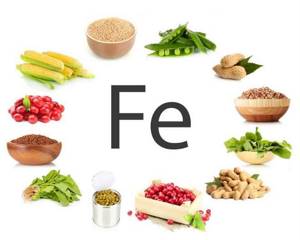
iron enters the human body through food containing microelements
Sources of iron. What foods contain Fe
The beneficial properties of iron are extremely important for health, so you need to follow the principles of proper nutrition. An excellent source of iron for humans are the following foods:
| Product group | High Fe content variety |
| Meat and offal | Beef, pork, chicken liver, lungs, heart and kidneys, rabbit, lamb, veal, duck |
| Fish and seafood | All varieties of fish, oysters, shrimp, mussels, black caviar, seaweed |
| Eggs | Chicken and quail |
| Dairy | Cheeses – mozzarella, tofu, Dutch, Roquefort, cheddar, Parmesan, processed Kostroma |
| Vegetables | Beets, beans, peas, soybeans, lentils, cauliflower, broccoli, corn, asparagus |
| Fruits and berries | Pomegranates, apples, plums, dogwoods, persimmons, lingonberries, strawberries |
| Greenery | Celery, spinach, chard, rhubarb, herbs and parsley root |
| Seeds and dried fruits | Raisins, dried apricots, prunes, figs, pine nuts, walnuts, pistachios, almonds, peanuts, poppy seeds |
| Cereals | Buckwheat, millet, barley, oatmeal, whole grains and wheat bran |
| Other products | Sunflower halva, brewer's yeast |
| Beverages | Cocoa |
When choosing where to get iron for the body, remember that this useful microelement is much better absorbed from animal products - up to 35-45%. Fe from plant foods is absorbed only by 5-20%.
dietary supplements
Iron for the body of a woman, man or child can be obtained using dietary supplements containing a useful microelement. They have a natural composition, are safe for health and do not cause side effects.
Among the most famous and popular dietary supplements is Hematogen, known to many since childhood. This sweet bar, reminiscent of toffee in taste, contains albumin, which is a natural “supplier” of iron.
Hematogen can be used during pregnancy and breastfeeding. But it is not a confectionery product, so be sure to remember the daily requirement - 30-40 g for an adult and 25 g for children. During pregnancy, the dosage of hematogen is increased to 50 g.

The pharmaceutical industry produces a wide range of drugs containing iron
Medicines
In case of severe iron deficiency anemia, a person’s iron requirement can be replenished with the help of special medications. The most common and effective means include:
- Ferroplex;
- Fenyuls;
- Maltofer;
- Ferrum-Lek;
- Ferro-Folgamma;
- Aktiferrin;
- Sorbifer Durules.
How many tablets or capsules to take per day is determined by the attending physician, since all medications have their own indications and contraindications for use.
Acceptable doses of iron
Knowing why iron is needed in the human body, many try to consume as many iron-deficient foods as possible. This approach can cause serious harm to health, since an increase in the concentration of this trace element leads to dangerous disruptions in the functioning of internal organs.
Permissible doses of microelements:
- toxic – 200 mg;
- fatal – 8-35 g.
Iron is a microelement that plays an extremely important role for the full functioning of the entire body. It takes part in the most important immune, metabolic and biochemical processes, DNA synthesis and oxygen transport to the cells of internal organs. Lack of iron can lead to dangerous health consequences. To compensate for the deficiency of a beneficial microelement, nutritional correction is required, and in some cases, taking dietary supplements and medications.
Signs of excess iron
Even when eating foods containing high concentrations of iron, iron excess does not occur. This is due to the fact that the body independently “filters” excess mineral compounds and takes exactly as much iron as it needs.
It is much more difficult for him to resist the ultra-high dosages of iron supplied with drugs. If iron-containing products and nutritional supplements are used too intensively, poisoning may occur. It makes itself felt by vomiting, headache, stool disorders and other symptoms.
Excess iron is also seen in a rare condition called hemochromatosis. With this disease, the body carries out a pathological accumulation of iron, which is manifested by serious disorders of the liver and other organs.
